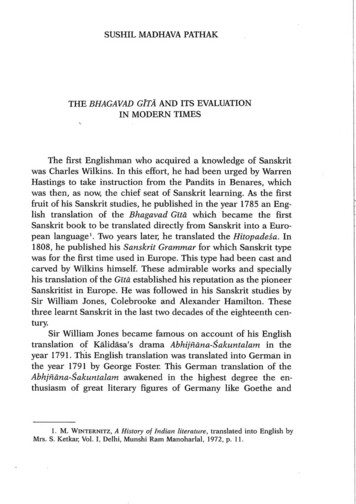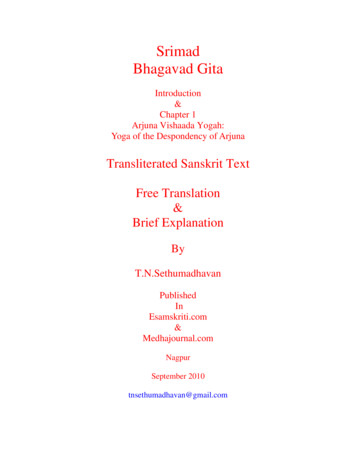
Transcription
SrimadBhagavad GitaIntroduction&Chapter 1Arjuna Vishaada Yogah:Yoga of the Despondency of ArjunaTransliterated Sanskrit TextFree Translation&Brief i.com&Medhajournal.comNagpurSeptember 2010tnsethumadhavan@gmail.com
Srimad Bhagavad GitaMethodology of PresentationT.N.SethumadhavanThe radiance of the Bhagavad Gita is being brought to the readers under this columnthrough the means of easy to handle tools. This arrangement consists of a series ofessays covering the entire Gita in a simple, direct and interactive style employing thetechnique of a Distance Education Programme.The presentation of each Chapter of the Gita will have¾ All transliterated Sanskrit Verses with a lucid translation and explanatorynotes divided into different topics for a clear-cut grasp of the subject¾ A brief account of the issues and concepts involved¾ Strategies to put the ideas discussed into practice and¾ A questionnaire for self-assessment by the readerThe periodicity of posting these essays would be about once in a fortnight barringunforeseen circumstances.In preparing these essays I have steered clear off all the scholastic debates andcontroversies with a view to reach out to the average modern educated youngpeople who require the strength of the Gita to wade through the current daytroubled waters. My purpose is just to help them to understand the essentialmessage of the Gita so that they will blossom into integrated persons full ofequanimity of mind, speech and action. Their needs in the context of our presenthabits of study were fully kept in view in this process.If this effort ignites the minds of the readers and prepares them to take a dip in theGita Ganga on their own, the objective of my mission would be accomplished. MayGanesha, The Lord of Wisdom, shower His grace on all of us in our voyage fromdarkness to light with the help of the Bhagavad Gita, the Essence of Knowledgeitself?AUMasatoma satgamaya tamasoma jyotirgamayamrityorma amritam gamayaom shantih , shantih, shantih ()()()
Introducing Srimad Bhagavad Gita:A User’s Manual for Every Day LivingT.N.Sethumadhavan“Live in the world but don’t be of the world. Live in the world but don’t let the worldlive within you. Remember it is all a beautiful dream, because everything is changingand disappearing. If you become detached you will be able to see how people areattached to trivia and how much they are suffering. And you will laugh at yourselfbecause you were also in the same boat before”. - OshoTHE GITA’S WIDE APPEALThe Bhagavad Gita was first translated into English by Charles Wilkins in 1785 andpublished by the British East India Company with an introduction by Lord WarrenHastings, the first British Governor-General of India, in which he prophetically wrote:“The writers of the Indian philosophies will survive when the British Dominion inIndia shall long have ceased to exist, and when the sources which it yielded of wealthand power are lost to remembrance”. He further wrote “I hesitate not to pronounce theGita’s performance of great originality, of sublimity of conception, reasoning anddiction almost unequalled and a single exception amongst all the known religions ofmankind”.The Gita deals with human problems in a human way. That is why it has atremendous appeal. It has inspired the human mind in India for centuries and today itcasts its spell on millions of people across the various parts of the world. It remainsthe most translated work in the Globe. The modern technology like the Internet hasfurther increased its reputation by carrying its message to every nook and corner ofthe world. A mere click on the word ‘Bhagavad Gita’ in the Google search enginethrows about 963,000 results. An incredible reach for any scripture!Among the great and extraordinary people who were inspired and found their outlookchanged by the timeless wisdom of the Gita are thinkers, writers, scientists andphilosophers like Mahatma Gandhi, B.G.Tilak, Sri Aurobindo, Albert Einstein, Dr.Albert Schweitzer, Herman Hesse, Ralph Waldo Emerson, Aldous Huxley, WaltWhitman, Henry David Thoreau, Annie Besant, Robert Oppenheimer Sir EdwinArnold and Carlyle to name but a few.In India it was left to Adi Sankara who lived in the 8th century A.D. to reveal thegreatness of the Gita to the world. He retrieved it from the mighty tomes of the epic,the Mahabharata, and wrote a brilliant commentary on it. It is this commentary whichprevails as a classic text even today. Later great acharyas like Ramanuja, Madhva,Vallabha and others came out with their own commentaries which are popular amongtheir followers. In modern times Sant Jnanesvar, B.G.Tilak, Aurobindo contributedtheir original thinking on the text.Despite this enormous popularity, the Bhagavad Gita remains a less understood but abetter known text; people know more about it than what is it about. On the analogy ofwhat the Bhagavad Gita says in Chapter 2, Verse 29 some look upon the book asmarvelous, a scripture of extraordinary or mysterious value, some others speak of the
book as wonderful. And still others though hearing its teachings do not comprehendits wonderful significance!Bhagavan Sri Krishna also says in the Gita (7.3) “Among thousands of men , one bychance aspires for perfection; even among those successful aspirants only one bychance knows Me in essence.” A question arises why such enlightened persons are sorare in our midst and why such an achievement is not within the reach of everyone.Vedanta being a subjective science rarely one tries to know how to remove one'sweaknesses and develop inner strength much less one tries to live up to the idealspropounded by it and bring about consequent re-adjustments in one's life. Very fewfeel this urge to evolve themselves and most of us do not even find the need for selfimprovement. We grope along by the voice of tradition, authority, herd-instinct andgroup-mentality. Of those who strive to see the truth and reach the goal, only a fewsucceed. Of those who gain the sight, not even one learns to live by the sight.No wonder once a teacher wanting to educate a child about the Gita asked him “Doyou know Gita”? The child replied “Yes, I know, that is the name of my next dooraunty”. The child obviously heard of Gita and had his own meaning of it in his mindand remained happy about it. That is the case with most of us today including thelarge mass of modern educated sections. Then where do we go from here? Again, theGita says by constant learning and practice one can certainly improve oneself. Let usattempt to heed that advice through this series of essays.WHAT IS THE GITA?The dictionary meaning of the word ‘Gita’ is a song or poem containing an inspireddoctrine and the word ‘Bhagavat’ means a blessed or adorable or venerable or divineOne. Hence Srimad Bhagavad Gita is variously called as ‘The Song of God’, ‘TheDivine Song’, ‘A Song of Fortune’, ‘The Lord’s Song’, ‘The Holy Song of God’,‘The Song of the Lord’, Gudartha Deepika, Gita Rahasya, Jnaneshwari,Bhavaarthadipika, Sadhaka Sanjeevani and so on. The noted English poet, journalistand a Principal of the Government Sanskrit College at Pune, Sir Edwin Arnold (18321904) called his famous poetic version of the Bhagavad Gita as ‘The Song Celestial’.The Bhagavad Gita’s another title is ‘moksha sastra’ or ‘Scripture of Liberation’.However, it is more popularly known as “The Gita”.The Bhagavad Gita is a sacred Hindu scripture, considered among the most importanttexts in the history of literature and philosophy. It finds a place in the Bhishma Parvaof the Mahabharata. It comprises of 18 chapters spread out in 700 verses. Its author isVeda Vyasa, the compiler of the Mahabharata who wrote this epic through the handsof the Lord of Wisdom, Sri Ganesha. Its teachings are considered timeless and theexact time of revelation of the scripture is considered of little spiritual significance.The teacher of the Bhagavad Gita is Lord Krishna, who is revered as a manifestationof God, The Bhagvan, Parabrahman.The content of the Gita is the conversation between Lord Krishna and Arjuna takingplace on the battlefield of Kurukshetra before the start of the war between the twoclans of brothers - the Kauravas and the Pandavas.
Responding to Arjuna's confusion and moral dilemma about fighting his own cousins,Bhagavan Krishna explains to Arjuna his duties as a warrior and prince and elaborateson different Vedantic concepts. This has led to the Gita being described as one of theprasthana traya, the triumvirate of the canons of Hindu Philosophy, the other twobeing the Upanishads and the Brahma Sutras.It is considered as a concise, practical, self-contained guide to play the game of life.During the discourse, Krishna reveals His identity as the Supreme Being (SvayamBhagavan), blessing Arjuna with an awe-inspiring vision of His divine universalform.The Gita itself tells us about what it is. At the end of the first chapter we find anarration reading as under:om tat sat iti srimad bhagavadgeetaasu upanishatsu brahma vidyaayaamyogashaastre sri krishnaarjuna samvaade arjuna vishaada yogo naamaprathamo'dyaayah “Thus in the Upanishads of the glorious Bhagavad Gita, the science of the Eternal, thescripture of Yoga, the dialogue between Sri Krishna and Arjuna, ends the firstdiscourse entitled: The Yoga of the Despondency of Arjuna”The narration as given above at the end of the first chapter occurs also at the end of allthe other subsequent chapters, the only difference being the respective title of thechapters. This narration is called sankalpa vakya' meaning an epilogue for thechapter. It reveals in a very concise form the glory and greatness of the Gita and statesthe theme of the concerned chapter.The meaning of this recital is as under:¾ Om Tat Sat: A designation for the Absolute enabling everybody to turntowards Godhead.¾ Gita is called: Upanishad because it contains the essence of all the Upanishadswhich are the revelations of the ancient sages.¾ Brahma Vidya or the science of the Eternal because it teaches about thechangeless Reality behind the ever-changing phenomenal world ofperceptions, emotions and thoughts.¾ Yoga Shastra because it is a scripture that explains the technique of rightliving and provides a practical guide to work it out in the form of Jnana Yoga,Karma Yoga, Bhakti Yoga and Raja Yoga.¾ Samvad because it is in the form of a dialogue between Krishna and Arjuna,the Divine and the human, the former teaching the latter how to functionsuccessfully and efficiently in a community.¾ This chapter is entitled Arjuna Vishaada Yogah' or the Yoga of despondencyof Arjuna.STORY OF THE MAHABHARATAIn the north of India, there flourished a kingdom with its headquarters at Hastinapur.King Pandu was ruling the kingdom after his father's death, as his elder brother,
Dhritarashtra, was born blind and therefore not qualified for the rulership according tothe tenets of that age. King Pandu had five sons who were known as Pandavas.Dhritarashtra had one hundred sons who were called as Kauravas, the eldest of whomwas Duryodhana. Bhishma was the uncle of Pandu and Dhritarashtra.After Pandu's death his children, Pandavas, were brought up and educated along withKauravas under the supervision of Bhishma and patronage of Dhritarashtra. Dronawas a skillful teacher who taught them all the techniques of warfare. Pandavas wereintelligent and brave. Within a short time they could master the art of warfare.Yudhishtira, the eldest of the Pandavas, succeeded his father as the king.Duryodhana was jealous of the Pandavas. When Yudhishtira was proclaimed a kingDuryodhana could not keep quiet and watch. He employed all foul means to destroyPandavas and every time he tried to kill them he met with failure. On Bhishma'sadvice the kingdom was divided into two parts - the better one with Hastinapur ascapital was taken by the Kauravas while the Pandavas took the other half and built anew beautiful capital called Indraprastha for themselves.Dhritarashtra was equally affectionate towards his sons and Pandavas but had theweakness to be sympathetic towards his eldest son's sorrows and disappointments.Once Duryodhana invited Yudhishtira for a game of dice wherein the former with thehelp of his cunning and deceitful uncle, Sakuni, defeated Yudhishtira by using allfraudulent means. As a result, Yudhishtira lost not only all his kingdom andpossessions but also Draupadi, the wife of all the Pandava brothers. Draupadi washumiliated by the Kaurava brothers to such an extent that an attempt was made todisrobe her in public. Her honor was saved by Bhagavan Sri Krishna, a great familyfriend of the Pandavas.Finally it was settled that Pandavas should live in the forest for twelve years in exileand further one year incognito untraced by any one. After successfully completingthese thirteen years of ordeal when the Pandavas claimed their kingdom Duryodhanarefused to part with even that much little land as could be covered by the point of aneedle.The good offices of Sri Krishna to bring sanity to Duryodhana who was intoxicatedwith power and greed proved futile. The Pandavas were left with no alternative but totake up arms against Kauravas to regain their kingdom lost through tricks, treacheryand chicanery.A war between Pandavas and Kauravas became inevitable and the preparations for theepic battle started. Both the sides mobilized their troops and took their respectivepositions in the battlefield at Kurukshetra, near modern Delhi.Bhagavan Sri Krishna was the charioteer of Arjuna, the mightiest of the Pandavabrothers. Arjuna asked Sri Krishna to place their chariot between the two armies toenable him to have a glimpse of all those with whom he had to fight. Although till thattime he was in full fighting spirit, when he saw his teachers, elders, brothers, relativesand friends standing before him ready for the fight, his determination gave way toweakness of head and heart. He lost his enthusiasm to fight and told Sri Krishna that
he did not want to wage the battle against his seniors, relations and friends for thesake of a paltry kingdom.When Arjuna refused to fight, Sri Krishna gave him a good peace of adviceenlightening him upon where his duty lay. This marvelous advice delivered by TheBhagavan in the battlefield at Kurukshetra is the immortal poem, the song divine, theglorious SRIMAD BHAGAVAD GITA which epitomizes the whole gamut ofknowledge contained in all the Scriptures.Sage Vyasa offered Dhritarashtra the power of sight which would enable him to seethe events of war. Unwilling to see the inevitable massacre of his sons, the blind kingdesired to know the full details of the war. To fulfill Dhritarashtra's request Vyasabestowed Sanjaya, the trusted minister of Dhritarashtra, with the divine intuitivevision by which he could know not only the incidents of the battlefield but also theideas in the minds of the warriors.After ten days of war, Bhishma, the commander of the Kaurava army was severelywounded and thrown off his chariot. When Sanjaya informed Dhritarashtra about thisincident the blind king became very sad and asked him to tell him all the details of thewar. The reporting of Sanjaya about the events of war including the dialogue betweenSri Krishna and Arjuna at the battlefield is contained in the Bhishma Parva ofMahabharata wherein The Gita text finds place. The Gita opens with the question ofthe blind king to Sanjaya asking him what happened on the battlefield when the twoarmies faced each other in the battle formation.CENTRAL THEME OF THE GITAThe Bhagvad Gita can be studied from different angles such as a historical document,a spiritual treatise, a scriptural text for daily chanting and prayer, a sublime poetry, anexposition of Grammar and meter, or a management manual, depending on one’s ownoutlook and purpose.The objective here is to study it as a spiritual text and try to find out its main theme.Our ancient Rishis have given us a six-point test to determine the main theme of atext. This is called ‘sadvidvidha tatparya nirnaya linga’. In the light of this six-factortest let us look at the Gita to discover its central theme.The 1st point is called upakrama and upasamhara - the beginning and conclusion of atext. The crux of the subject in the text starts with Arjuna’s confusion, his acceptanceof the delusion and surrender to the Lord as a sishya with a request to teach him whatis the best for him. The text ends with his statement that all his doubts were cleared,his delusion is gone and he regained his memory of the Self. This kind of beginningand end of the text shows that the Bhagavad Gita contains the Knowledge thatremoves the delusion and bestows the Supreme Good.Even from the teacher’s view point, the text starts from Sri Krishna telling Arjuna thathe is grieving for that which should not be grieved for thereby explaining how sorrowis borne of delusion. It ends by asking Arjuna whether the delusion had gone. Thismakes it clear that the entire purpose of the dialogue between Krishna and Arjuna was
aimed at removing spiritual ignorance which is the cause of delusion. Thus theremoval of sorrow and delusion (soka moha nivritti) is the main theme of the Gita.The 2nd point is called abhayasa - repetition and emphasis in the text. The 2nd chaptergives ample evidence to this aspect. Krishna frequently tells Arjuna not to grieve andputs forward the reasons for that view from several angles like the true knowledge,duty, ignominy etc. Similarly, the concept of sthitaprajna has been highlighted inseveral ways at various places. This shows imparting Self-Knowledge is the key notein the text.The 3rd point is called apurvata - the novelty or uniqueness of the theme. Sri Krishnacalls this Self-Knowledge as a secret, guhyam because normal extroverted mindscannot grasp it and hence very few succeed in knowing it. Similarly, moderation in allwalks of our lives has been stressed at many places. The teachings of the Gita are thusunique.The 4th point is phalam or the fruit or the end result of the study of the text. Removalof sorrow and confusion and attainment of clear thinking and supreme knowledge enlightenment - are the end result of the study of the text.The 5th point is arthavada - positive praise of the subject and negative condemnationof the opposite. We find many slokas in the text extolling the supreme SelfKnowledge and condemning spiritual ignorance. Thus attaining the SupremeKnowledge is the goal of the Gita.The 6th and the last point is upapatti - illustration and reasoning. We find in the textthat Krishna has been giving a lot of logical explanations and reasoning to convinceArjuna about his teachings. He uses profusely the word ‘tasmat’ meaning ‘therefore’.His arguments are given from many standpoints, the main goal of all His efforts beingelimination of sorrow and delusion through Self-Knowledge. The nature of Self isalso revealed through examples and reasoning. These indicate the Supremeknowledge ( tattva jnanam) as the main subject matter of the Gita.Therefore Self-Knowledge (atma jnana) which eliminates our ignorance and theconsequent problems created and bestows the ultimate good for all of us (shreyas) isthe core theme of the Gita.OVER-VIEW OF THE GITAThe entire Bhagavad Gita can be divided into five topics viz.1. Identifying the problem (covered in the 1st and the starting portions of the 2ndchapters of the Gita).2. Finding a solution (covered in the major portion of the 2nd chapter andreiterated in the 7th, 9th and 13th chapters.3. Implementing the solution (This theme is dealt with in the 3rd, 5th, 12th and 18thchapters).4. Understanding the values of life (stated in many places in the Gita andparticularly in the 16th chapter) and5. Achieving perfection (elaborated in the 2nd, 5th, and 14th chapters).
Arjuna’s misunderstanding, his inability to see things as they are and consequent griefand self-pity just at the crucial moment of war are the problems. The solution to themcan be short term which will only be of temporary nature or long term which will beof permanent nature. The Gita offers a long term solution with which anybody canface any situation in life at any time anywhere. This spiritual solution teaches us tolook at life as a whole and live a whole life. Finding a solution is just not enough. Wemust know how to implement it. The Gita provides us with a practical guidance thathelps us to understand how to live according to the guidelines offered.But living a life according to the guidelines offered is also not adequate unless it isspiced with certain basic vision and values. If a person’s vision of life is limited tomundane happiness derived from the senses, he will merely spend his life time ineating, drinking and making merry. His value system will revolve round makingmoney by any means to satisfy his never ending needs. But the value system of aperson with a philanthropic bent or an animal lover or an environmentalist orspiritually oriented will be entirely different. The Gita provides us with such anenlarged vision of life laying the foundation for a sense of fulfillment.Finally, the Gita gives us the vision of a person who has gained the supremeKnowledge and lives anchored in it. One who faces problems and crisis in life gainsthe vision of Truth, puts it into practice, and lives according to that value system. Hebecomes a jivan mukta, liberated in this very life. He is called a sthita prajna and theGita gives us a vivid description of his nature.Such an analytical understanding of the various topics in the Bhagavad Gita makes iteasy for us to study it fruitfully and gives us a ready reference point to check out theslokas (verses) according to our requirement.MAIN CONCEPTS OF THE GITAThe main philosophical subject matter of the Bhagavad Gita is the explanation of fivebasic concepts.¾ Jiva, the individual soul or the living being¾ Jagat, the universe he lives in or nature or matter¾ Jagadishvara, the creator of the universe or the Supreme Controller and therelationship between Jiva, Jagat and Jagadishvara.¾ Dharma (Duty in accordance with Divine law)¾ Kaala (Time)Krishna counsels Arjuna on the greater idea of dharma, or universal harmony andduty. He begins with the tenet that the soul (Atman) is eternal and immortal. Any'death' on the battlefield would involve only the shedding of the body, whereas thesoul is permanent.In order to clarify his point, Krishna expounds the various Yoga processes andunderstanding of the true nature of the universe. He describes the yogic paths ofdevotional service -Bhakti Yoga, action - Karma Yoga, meditation - Dhyana Yoga orRaja Yoga and knowledge - Jnana Yoga.
Fundamentally, the Bhagavad Gita proposes that true enlightenment comes fromgoing beyond identification with the temporal ego, the 'False Self', the ephemeralworld, so that one identifies with the truth of the immortal self, the absolute soul orAtman.Through detachment from the material sense of ego, the Yogi, or follower of aparticular path of Yoga, is able to transcend his/her illusory mortality and attachmentto the material world and enters the realm of the Supreme.Krishna does not propose that the physical world must be abandoned or neglected.Rather, one's life on Earth must be lived in accordance with greater laws and truths;one must embrace one's temporal duties whilst remaining mindful of timeless reality,acting for the sake of service without consideration for the results thereof. Such a lifewould naturally lead towards stability, happiness and, ultimately, enlightenment.In the Bhagavad Gita Krishna refers to the war about to take place as ‘DharmaYuddha’, meaning a righteous war for the purpose of justice. He also states that heincarnates in each age (yuga) to establish righteousness in the world.WHY STUDY THE GITA?Srimad Bhagavad Gita has been a source of inspiration and enlightenment forgenerations. The message of the Gita is not merely a general spiritual philosophy orethical doctrine but it has a bearing upon the practical aspects in the application ofsuch principles in our day-to-day lives. It is indeed "An Users' Manual for the Practiceof the Art of Right Living".The centuries old Bhagavad Gita continues to be the most relevant beacon light for allof us today. The modern man, like Arjuna, is at the crossroads where the focus ismore on improving the Standard of Living rather than the Standard of Life, more onthe Stock Exchange Index than on the Human Development Quotient, more on theCost of Living than on the Quality of Life. This has resulted in his disorientation andimbalance in an environment of shifting values. While science aims to enhance thecomfort of human life, spirituality teaches us how to be comfortable with what wehave. That is the difference. In this scenario, the Gita is the only source of strength forthe development of an integrated personality, a complete man, within us.The Gita teaches how to achieve harmony with divinity in the midst of disharmony bysubduing all outward energies and remaining in equanimity with pairs of oppositeslike pain and pleasure, aversion and attraction, success and failure etc. The focus ofthe Gita is moderation and its aim is the total surrender of man before the Supremewhile continuing to perform his duties in the spirit of Yoga.The problem that is facing us today is that while the world is coming closer physicallyit is drifting apart mentally and emotionally. Hence all the conflicts and violence,destruction and damage across the globe. The urgent need, therefore, is thereconciliation and reconditioning of the human mindset, to inculcate a global visionand bring about the universal brotherhood.
The Gita is specially suited for the purpose, as it attempts to bring together varied andapparently antithetical forms of the consciousness and emphasizes the rootconceptions of humanity which are neither ancient nor modern, belonging neither tothe east nor the west, but eternal and universal.Its beauty and sublimity lie in its everlasting relevance to the daily problems of humanlife, either occidental or oriental. It prescribes the methods which are within the reachof all. It has a message of solace, freedom, salvation, perfection and peace for allhuman beings. The more you study it with devotion and faith, the more you willacquire deep knowledge, penetrative insight and clear, right thinking. It is indeed arecipe for sane living for every man and woman across the world.THOUGHTS FOR SELF EVALUATION1. Where is the Bhagavad Gita to be found?2. What is the historical epic Mahabharata?3. Who is the author of the Mahabharata?4. What is the Bhagavad Gita?5. In what form the Gita was written?6. Where was the Bhagavad Gita originally spoken?7. What is the composition of the Bhagavad Gita?8. What is the central theme of the Gita9. What are the broad topics covered in the Gita?10. What are the main concepts elucidated in the Gita?11. What can be learned by the study of Srimad BhagavadGita?12. Why the Gita is popular in the world even today?We will take up Chapter 1 of the Bhagavad Gita next time.HARIH OM
Bhagavad Gita - Chapter 1 (Part-1):Arjuna Vishaada Yogah:Yoga of the Despondency of ArjunaT.N.SethumadhavanINVOCATIONGenerally before commencing the study of the Bhagavad Gita text, it is customary tostudy the meditation verses on the Gita called Gita Dhyana Slokas. We do not knowwho composed them. It is a set of 9 verses recited as invocation, dedication andprayer to the Gita Knowledge and its glory. For our purposes let us take up one of theverses and understand its meaning.Prapanna paarijaataaya totra vetraika paanaye Jnaanamudraaya krishnaaya geetaamrita duhe namah Salutations to Bhagvan Krishna, with His right hand in Jnana Mudra, the bestower ofall needs to those who surrender to Him completely, the milker of the divine nectar ofthe Bhagavad Gita, the holder of the whip in one hand for driving the cows.This verse describes Sri Krishna with His right hand held in Jnana Mudra - inknowledge posture - wherein the thumb is joined to the forefinger and all the otherthree fingers are stretched out, the gesture symbolizing knowledge. This is aremarkable concept in Indian Vedantic philosophy and spirituality which indicatesthat our body postures have psychological counter parts. As the mind is, so is thebody; bodily expressions being the manifestation of the working of the mind or theeffect of psyche. This is what we call ‘body language’ in the modern business schoolterminology. It means that there is nothing in this world so purifying as Knowledge.We offer our obeisance to Sri Krishna who is the embodiment of Knowledge and whoimparts such knowledge to all those who seek it from Him. This is what Arjuna doesin the Gita. That knowledge is the Supreme Knowledge - the knowledge of theAbsolute Reality, the knowledge of Dharma, the knowledge of righteousness, theknowledge about the right way of living.With this prayer let us start our journey in the Gita Ganga and crave for Sri Krishna’senlightenment.PREAMBLEThe 1st Chapter in the Gita introduces the scene, the setting, the circumstances and thecharacters involved determining the reasons for the espousal of the Bhagavad Gita.The scene is the sacred plain of Kurukshetra. The setting is a battlefield. The situationis that the war between the two clans of brothers, the Kauravas and the Pandavas isabout to begin.The main characters are Bhagavan Sri Krishna and the valiant Arjuna from the side ofPandavas and Duryodhana from the side of Kauravas in the midst of large armies onboth the sides led by their respective commanders.
After noticing the principal warriors on both the sides, Arjuna falls into the mood ofdeep dejection and melancholy due to the fear of destruction of friends and relativesin the course of the impending war leading to his resolve not to take up arms againsthis kith and kin. This is the subject matter of this Chapter and hence it is called“A
THE GITA'S WIDE APPEAL The Bhagavad Gita was first translated into English by Charles Wilkins in 1785 and published by the British East India Company with an introduction by Lord Warren Hastings, the first British Governor-General of India, in which he prophetically wrote:
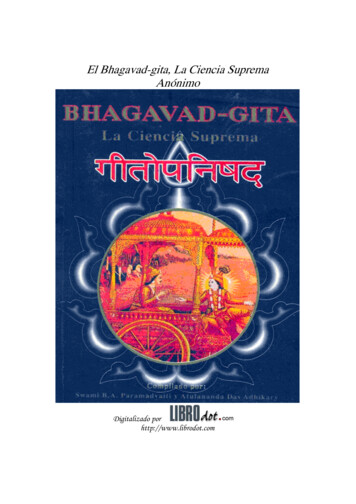


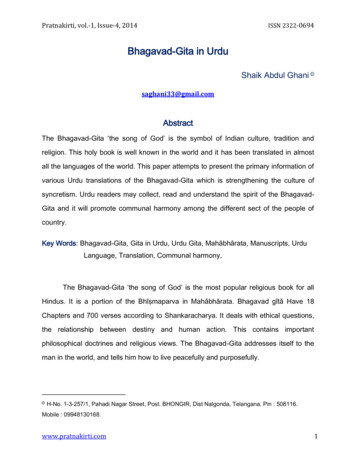
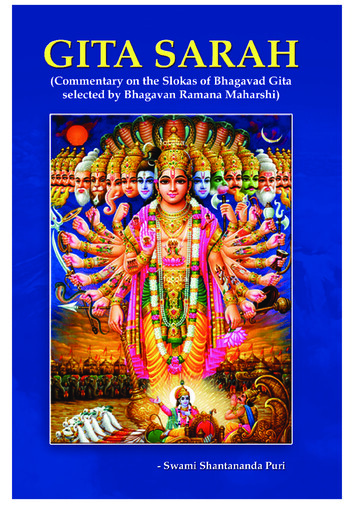

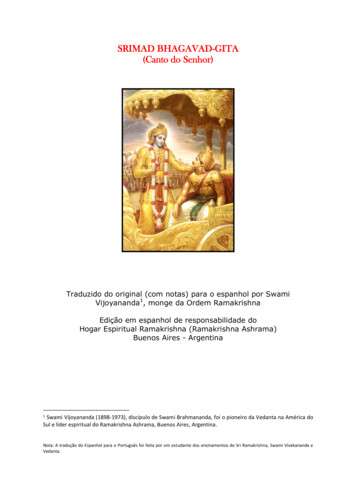
![Om namo bhagavate vasudevaya [] satyam param dhimahi](/img/30/thousand-blessings-mantra.jpg)

